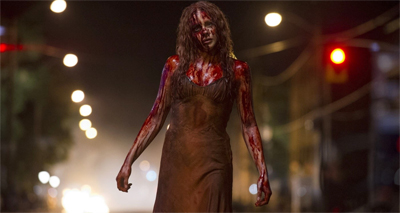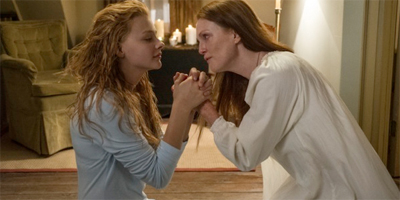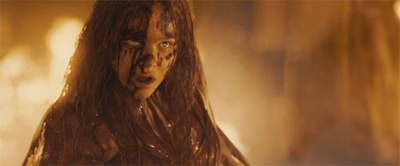Carrie is, for the first half of its runtime, a fairly effective attempt to update Stephen King’s iconic high school horror story about religious repression and teenage issues. While Chloë Grace Moretz isn’t quite as memorable and quite as nuanced as Sissy Spacek was in Brian De Palma’s much-loved original adaptation, she gives a strong central performance. However, the film falls apart a bit as it enters the second half, turning into a large-scale action set piece that feels more like a superhero disaster movie than a psychological teen horror.
There’s a lot of good stuff here. Writers Lawrence D. Cohen and Roberto Aguirre-Sacasa do an excellent job updating the movie for modern audiences. They update the trappings with nods to social media and cyber-bullying, while recognising the fact that the core of King’s novel remains relevant. It always sucks to be a teenager, no matter what decade you’re in. It always sucks to be uncool and unpopular, regardless of whether kids are listening to LPs or MP3s.
The touches like cell phones and on-line videos are used well, conveying the idea that modern technology really just makes high school an even more unpleasant environment for any lonely individual who happens to provoke the wrath of the popular clique. And Carrie is at its strongest when it’s exploring that teenage sense of being locked out. King really perfectly channelled the sense of anger and resentment that can build up in teenagers.
It’s a familiar theme in King’s work, with Rage serving as a companion piece that is more uncomfortably close to reality than the telekinetic pyrokinesis. (“Pyrokinesis” being a rather clumsy word that King himself invented in Carrie.) Unlike a lot of the more recent remakes of horror and science-fiction cult classics, the remake of Carrie makes a compelling case for its own relevance. In this era of highly-publicised teenage suicide and murder, the core themes of the work really shine through. Even the religious repression that Carrie experiences in her home life seems just as relevant and just as pertinent as ever.
Director Kimberly Peirce does a really good job with the first half of the film, genuinely building towards the movie’s inevitable tragic climax. There’s never a moment where Peirce doubts the audience’s savvy – she knows that the viewers are as aware as she is that Carrie is building towards a tragic meltdown. As much as a happy ending might seem possible at certain points, and as much as forces might conspire to offer a resolution to this plot that might end up with most of the characters living happily ever after, Peirce uses these hints of reprieve to only pile the sense of dread and fatality on heavier.
Moments of compassion and empathy between other characters only heighten the tragic atmosphere, as the audience recognises the inevitability of a catastrophic outcome. Peirce shrewdly realises this and plays well to that inevitability during the movie’s first half. Ever moment that Carrie smiles only makes the audience more uncomfortable, realising that this story simply cannot have a positive outcome. Darkness will draw Carrie in, even as we watch.
However, Carrie stumbles around the half-way point and never recovers. As wonderful a job as Peirce does conveying the grim reality of Carrie’s life in school and at home, she seems to struggle a bit when it comes to manifesting Carrie’s unique gifts. All too often, the big moments in Carrie feels like a conscious attempt to channel the indie success of Chronicle – right down to the casting of actor Alex Russell in a supporting role. Carrie gesticulates and the camera whirls around and the CGI is used as if we’re watching an audition for one of the X-Men films.
While that’s a very valid approach to a movie about telekinesis and pyrokinesis, one that updates the novel’s visual language for the modern movie era by reference to a popular genre, it doesn’t gel well with the general mood of the piece. It feels as though the film loses its powerful intimacy the moment that things begin to go truly wrong for Carrie – that the character vanishes into some sort of comic book supervillain, and there’s a massive narrative gulf left amid all the large-scale destruction and carnage.
This decision influences other aspects of the narrative, undercutting the uncertain horror of Carrie’s powers and trying to make them seem like something almost familiar to Carrie and to movie-goers. Apparently, Carrie is able to not only master her gifts, but comes to understand and account from them completely. At one point, having read a few books on the topic, Carrie is able to tell her mother that telekinesis is genetic, passed through the bloodline – and she seems strangely certain that her grandmother had it.
This is compounded by a sense that the script quickly forgets all the fun modern touches that really helped cement the first half as a film worth watching. As the movie builds towards the climax, it seems like everybody forgets that mobile telephones exist, despite how crucial they were to the plot only a few moments earlier. Ironically, the climactic “race against time” sequence is initiated by a mobile telephone, but the movie glosses over the fact that a simple phone call should be equally able to resolve it.
The old “nobody has or answers a mobile” trope is one of the ways that classic horror has often struggled to deal with advances in modern technology. Instead, it seems the genre too afraid of change to try to update convention and instead content to pretend that an entire technological revolution never occurred – or to offer “no signal” as a contrived excuse. Instead, we get lots of tense shots of a character running, racing against time, because that’s much more dramatic.
Even outside of conventional horror movie plot holes that creep in around the edges, the second half suffers from a lack of focus as Carrie grows into something of a monster. There is an obvious solution here. The character of Sue Snell – one of Carrie’s teenage tormentors – is clearly intended to step up to the plate in the film’s second half. She’s written in such a way that the film really seems to intend for her to become the focal point of audience identification. Unfortunately, it doesn’t quite work.
Part of this is down to the fact that the script never really develops Sue Snell enough, remaining too tightly focused on Carrie for the first half. Of course, that’s a legitimate decision – Carrie is much more interesting, and this is her story. However, it means that we don’t really care too much about Sue by the time the script pushes Carrie into full-scale natural disaster mode. It doesn’t help that Gabriella Wilde doesn’t have anything approaching the screen presence to pull it off. Moretz has the more interesting role, but is also the more interesting performer.
Admittedly, Wilde suffers from the fact that pretty much all of the film’s stronger supporting players disappear from the final act. Judy Greer makes a nice impression as the only truly sympathetic member of staff at Carrie’s school, but she understandably fades from view after the climax. Barry Shabaka Henley is wonderful as the school’s principle who has difficulty discussing feminine hygiene issues, referring to tampons and sanitary towels nervously as “… things” and timidly offering Carrie “some juice.” Even Ansel Elgort makes an impression as Sue’s dim-witted but well-meaning boyfriend, Tommy.
Carrie does work a lot better than it should. For the first half, it’s a fascinating update of a horror classic, offering relevance and insight that justify the decision to re-tell this most familiar of stories. Unfortunately, the problems become evident in the second half, as the movie loses sight of that relevance and that insight amid the carnage.
Filed under: Non-Review Reviews | Tagged: Brian dePalma, Carrie, Chloë Grace Moretz, Gabriella Wilde, Julianne Moore, Kimberly Peirce, Lawrence D. Cohen, Margaret White, Roberto Aguirre-Sacasa, Sissy Spacek, stephen king, Sue Snell |



























Needless to say, I didn’t like this near as much as you (I scored it an F-minus), but you make your case well. Good review!
Thanks.
I didn’t love it, but I didn’t think it was absolutely unforgivable. A lot of nice ideas, foiled by the bits where it thought it was an X-Men spin-off and a weak secondary character/actor.
Thanks for this comprehensive review. I tend to torture myself by watching remakes to see how they stack in regards to the original piece and Carrie has coloured me curious since I heard about it. The information was well presented and set out fantastically, it’s a shame to hear that Snell is underdeveloped as a character seeming as in the original film she is given much more focus. I prefer to tread through reviews before seeing a film and because of what you felt toward the film I’ll most likely rent it. Again, great review! 🙂
Yep. It’s not terrible, just not great. And the film doesn’t seem to understand that Snell needs to somewhere near as interesting as Carrie for the climax switcheroo to work. (It’s a monster story where you’ve been rooting for the monster.)
Yes, you nailed it: “as it enters the second half, turning into a large-scale action set piece that feels more like a superhero disaster movie.” Only superheroes can stop cars. I wrote a short essay on Carrie called “The Temptation to Seek Revenge.” If you would like to read it, here is the link: https://21stcenturyfilms.wordpress.com/2014/08/25/carrie/
Thanks for the link!
Hi Darren, I’m going to repost my comment as I moved my review to a new blog URL.
Thanks Chris, fire ahead!
Hi Darren, feel free to delete all of my other comments, esp the one with the wrong URL. Have a great day, Chris
I really like your observation that the second half “feels more like a superhero disaster movie.” Carrie is like a Marvel comic super-villain. I wrote a short essay on Carrie called “A Warning to School Bullies.” If you would like to read it, here is the link: https://christopherjohnlindsay.wordpress.com/2015/05/01/carrie-2013/